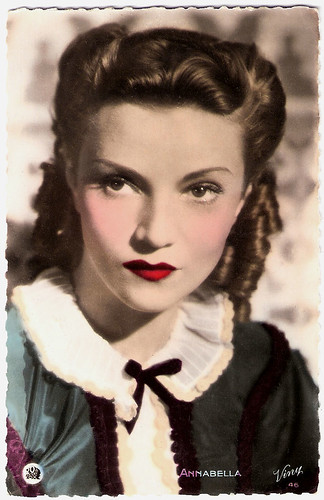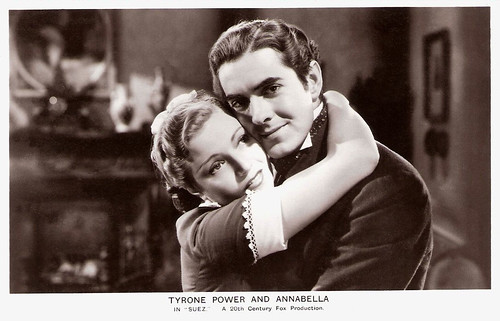Elegant Annabella (1909-1996) was France's most popular actress during the mid 1930s, but she also achieved some success in Hollywood films of the late 1930s.
![Annabella]()
French postcard by EPC, no. 1. Photo: Fox Film.
![Annabella]()
French postcard by Viny, no. 46. Photo: 20th Century Fox.
![Annabella]()
Small collector's card. Photo: J. Mandel.
![Annabella]()
British postcard by Art Photo, no. 180.
![Annabella]()
French postcard by EPC (Editions et Publications cinématographiques), no. 1. Photo: Fox Film.
Napoléon
Annabella was born as Suzanne Georgette Charpentier in La Varenne Saint Hilaire, France in 1909. In 1926 her father sent her photograph to a producer friend, who arranged her first screen role. This debut at age 16 was in the silent masterpiece Napoléon/Napoleon (Abel Gance, 1927), which was re-edited and re-issued in 1934. Soon followed bigger parts in films like Maldone/Misdeal (Jean Grémillon, 1928) and Autour d'une enquête/Inquest (1931, Henri Chomette, Robert Siodmak). Her breakthrough came with two delightful films by René Clair, Le Million/The Million (1931) and Quatorze Juillet/July 14 (1933). The following decade she established herself as one of France's most popular cinema actresses. She starred opposite Charles Boyerin La Bataille/The Battle (Nicolas Farkas, Victor Tourjansky, 1933). In 1936 she won the Volpi Cupfor Best Actress at the Venice Film Festival for the war drama Veille d'armes/Sacrifice of Honor (Marcel L’Herbier, 1935). Other successes were La Bandera/Escape from Yesterday (1935, Julien Duvivier) opposite Jean Gabin, Anne-Marie (Raymond Bernard, 1936) with her first husband Jean Murat, and Hôtel du Nord (Marcel Carné, 1938).
![Annabella]()
French postcard by Europa, no. 36. Photo: Les Films Osso. Annabella played a.o. in the Osso Films production Un soir de rafle (Carmine Gallone, 1931).
![Annabella]()
French postcard, no. 8. Photo: Fox Film.
![Annabella]()
French postcard, no. 10.
![Annabella]()
French postcard by EPC. Photo: T. Piaz.
![Annabella]()
Vintage postcard. Photo: Fox Film.
Tyrone Power
In 1936 Annabella went to England to star in three films, including the first British Technicolor production, Wings of the Morning (Harold D. Schuster, 1937), Under the Red Robe (Victor Sjöström, 1937) and Dinner at the Ritz (Harold D. Schuster, 1937). In Wings of the Morning she was cast opposite Henry Fonda, and her success in this role led her to Hollywood. She appeared in Suez (Allan Dwan, 1938) with Loretta Young and Tyrone Power. Her romance with Power was widely reported by movie magazines of the day, and in 1939 they were married. During the 1940’s her career began to wane, although she achieved a notable success with 13 Rue Madeleine (Henry Hathaway, 1947) opposite James Cagney. In 1948 she returned to France after her marriage to Tyrone Power ended. The next year she tried a come-back in films like Dernier amour/Last Love ( Jean Stelli, 1949), but in 1954 she retired after a guest appearance in the American tv series Suspense. Professing that Power was the only love of her life, Annabella never remarried after their divorce. Anne, her daughter by Jean Murat, was the wife of actor Oskar Werner for 12 years until their divorce in 1971. In 1985 Annabella did one final appearance in the short film Elisabeth (Pierre-Jean de San Bartolomé, 1985). She died of a heart attack at her home in Neuilly, France, in 1996.
![Annabella]()
Dutch postcard by City Film, no. 494, sent by mail in 1935.
![Gustav Fröhlich & Annabella]()
Dutch postcard by Filma. Annabella and German actor Gustav Fröhlich were the leads of the Austrian film Sonnnenstrahl/Sunshine (Paul Fejos, 1933).
![Annabella and Gustav Fröhlich in Sonnenstrahl]()
Dutch postcard by City Film, no. 512. Annabella and Gustav Fröhlich in Sonnenstrahl/Ray of Sunlight/Rayon de soleil (Pål Fejös, 1933).
![Annabella, Tyrone Power]()
British postcard by Real Photograph, London, no. FS 177. Photo: 20th Century Fox. Publicity still for Suez (Allan Dwan, 1938), a highly fictionalized biographical account of the builder of the Suez canal, Ferdinand de Lesseps, played by Tyrone Power.
![Annabella]()
German postcard by Ross Verlag, no. A 1327/1, 1937-1938. Photo: 20th Century Fox.
Sources: AllMovie, TCM, Wikipedia, and IMDb.

French postcard by EPC, no. 1. Photo: Fox Film.

French postcard by Viny, no. 46. Photo: 20th Century Fox.

Small collector's card. Photo: J. Mandel.

British postcard by Art Photo, no. 180.

French postcard by EPC (Editions et Publications cinématographiques), no. 1. Photo: Fox Film.
Napoléon
Annabella was born as Suzanne Georgette Charpentier in La Varenne Saint Hilaire, France in 1909. In 1926 her father sent her photograph to a producer friend, who arranged her first screen role. This debut at age 16 was in the silent masterpiece Napoléon/Napoleon (Abel Gance, 1927), which was re-edited and re-issued in 1934. Soon followed bigger parts in films like Maldone/Misdeal (Jean Grémillon, 1928) and Autour d'une enquête/Inquest (1931, Henri Chomette, Robert Siodmak). Her breakthrough came with two delightful films by René Clair, Le Million/The Million (1931) and Quatorze Juillet/July 14 (1933). The following decade she established herself as one of France's most popular cinema actresses. She starred opposite Charles Boyerin La Bataille/The Battle (Nicolas Farkas, Victor Tourjansky, 1933). In 1936 she won the Volpi Cupfor Best Actress at the Venice Film Festival for the war drama Veille d'armes/Sacrifice of Honor (Marcel L’Herbier, 1935). Other successes were La Bandera/Escape from Yesterday (1935, Julien Duvivier) opposite Jean Gabin, Anne-Marie (Raymond Bernard, 1936) with her first husband Jean Murat, and Hôtel du Nord (Marcel Carné, 1938).

French postcard by Europa, no. 36. Photo: Les Films Osso. Annabella played a.o. in the Osso Films production Un soir de rafle (Carmine Gallone, 1931).

French postcard, no. 8. Photo: Fox Film.

French postcard, no. 10.

French postcard by EPC. Photo: T. Piaz.

Vintage postcard. Photo: Fox Film.
Tyrone Power
In 1936 Annabella went to England to star in three films, including the first British Technicolor production, Wings of the Morning (Harold D. Schuster, 1937), Under the Red Robe (Victor Sjöström, 1937) and Dinner at the Ritz (Harold D. Schuster, 1937). In Wings of the Morning she was cast opposite Henry Fonda, and her success in this role led her to Hollywood. She appeared in Suez (Allan Dwan, 1938) with Loretta Young and Tyrone Power. Her romance with Power was widely reported by movie magazines of the day, and in 1939 they were married. During the 1940’s her career began to wane, although she achieved a notable success with 13 Rue Madeleine (Henry Hathaway, 1947) opposite James Cagney. In 1948 she returned to France after her marriage to Tyrone Power ended. The next year she tried a come-back in films like Dernier amour/Last Love ( Jean Stelli, 1949), but in 1954 she retired after a guest appearance in the American tv series Suspense. Professing that Power was the only love of her life, Annabella never remarried after their divorce. Anne, her daughter by Jean Murat, was the wife of actor Oskar Werner for 12 years until their divorce in 1971. In 1985 Annabella did one final appearance in the short film Elisabeth (Pierre-Jean de San Bartolomé, 1985). She died of a heart attack at her home in Neuilly, France, in 1996.

Dutch postcard by City Film, no. 494, sent by mail in 1935.

Dutch postcard by Filma. Annabella and German actor Gustav Fröhlich were the leads of the Austrian film Sonnnenstrahl/Sunshine (Paul Fejos, 1933).

Dutch postcard by City Film, no. 512. Annabella and Gustav Fröhlich in Sonnenstrahl/Ray of Sunlight/Rayon de soleil (Pål Fejös, 1933).

British postcard by Real Photograph, London, no. FS 177. Photo: 20th Century Fox. Publicity still for Suez (Allan Dwan, 1938), a highly fictionalized biographical account of the builder of the Suez canal, Ferdinand de Lesseps, played by Tyrone Power.

German postcard by Ross Verlag, no. A 1327/1, 1937-1938. Photo: 20th Century Fox.
Sources: AllMovie, TCM, Wikipedia, and IMDb.